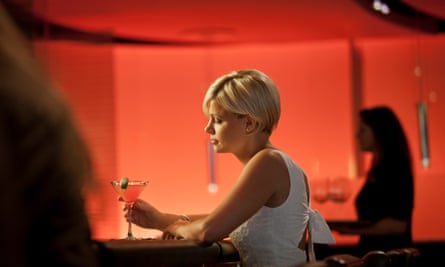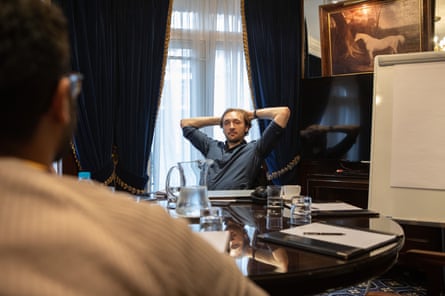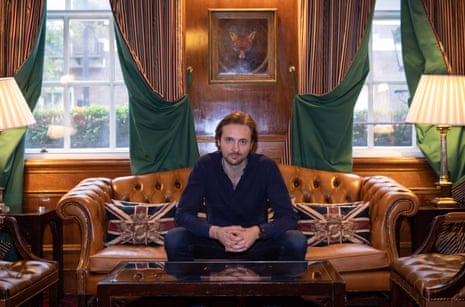In an upmarket bar near Oxford Circus in London, I am watching two men hit on women with all the desperation of a doomed cavalry charge. But without the heroism.
Mike and Raj (not their real names) circle the bar, scanning for women, drinks held at an awkward right angle to their chests. When they identify a target, they approach. The women stiffen, their smiles tightening. They swirl drinks with straws and chit-chat politely before mentioning boyfriends – real or imagined. The men retreat, regroup, identify fresh women. Advance, engage, retreat. On and on it goes.
I’m standing with the man coordinating this operation, the British pickup artist Johnny Cassell, as he watches as Mike and Raj – his students – run drills. Tonight is the culmination of Cassell’s intensive, day-long “Impactful Connection” workshop. For £700, Cassell promises to help men “master the art of attracting the women you truly want”. But watching as Mike and Raj hit on women indiscriminately, it looks as if any women will do.
It has been a long and disturbing day. Arriving at the venue, a four-star Mayfair hotel that morning, I had found Cassell, 31, in a black mood: a client had just dropped out. Tall and handsome, with a wolfish air, Cassell switches between being charming and cold. He does not like being contradicted or mocked. At one point during the session, I joke about spreadsheets and GDPR violations. Cassell is visibly displeased.

For the uninitiated, pickup artists (PUAs) are typically men – female artists are much rarer – who attempt to coax women into having sex with them through a mixture of flattery, psychological manipulation and coercion. The movement has a surprisingly long pedigree, dating back to Eric Weber’s now almost 50-year-old manual How to Pick Up Girls. Today, this seems relatively sedate stuff. Weber writes, “the most important tenet of a pick up is that it’s mutual … Women are entitled to say ‘no’, plain and simple.” But the community really exploded into the public consciousness with the publication of Neil Strauss’s 2005 international bestseller The Game, which sold 2.5m copies. It introduced a generation of men to the murky, underhand world of pickup artists and their nefarious tactics, such as negging – insulting a woman to undermine her confidence, and make her feel as if she has to seek your approval – or peacocking, where you dress flamboyantly as a talking point to hit on women. I went to university two years after The Game was published, and watched its influence spread like a virus through the men in my year: I don’t think I went on a night out in 2007 without some drunk rugby player trying to “neg” me.
What was once an underground community has grown into a seduction industry valued at $100m (£75m). “The basic premise of all seduction teaching and practice is that interactions between men and women are subject to certain underlying principles that, once understood, can be readily manipulated,” explains Dr Rachel O’Neill of Warwick University, the author of Seduction: Men, Masculinity and Mediated Intimacy. “This is an impoverished view of sex and relationships, in which intimacy is less something to be experienced for its own sake and more something to be achieved for other ends.”
With the advent of the internet, elements of the pickup artist community’s ideology hardened into something darker. “[It] paved the way for other masculinised self-help formations to emerge, such as Jordan Peterson’s 12 Rules for Life,” says O’Neill. Peterson, a Canadian academic, published his bestselling self-help tome in 2018 and is a critic of feminism. “It also connects with masculinist factions such as the incel movement [“involuntary celibates” – characterised by an extreme hatred of women], and men’s rights activists.” This globalised network of pickup artists, men’s rights activists and incels all emerged out of the same primordial sludge.

Attending today’s workshop are Mike, a 31-year-old tech worker, and Raj, 26, who lives in Dubai and works in finance. We sit around a circular table in a panelled conference room. Oil paintings of horses stare down at us. “I’ve been doing this for 14 years,” Cassell says. “It started off as a need for myself. Now I teach other people.”
Raj uses PUA terminology abundantly. “I have an issue with approach anxiety,” he says, meaning that he gets nervous hitting on women for the first time. He also refers to “sarging”, the process of picking up women. Both Raj and Mike are (perhaps unsurprisingly) edgy around me. I shunt my chair into a corner and arrange my features into a neutral expression.
The workshop begins with Cassell urging Raj and Mike to pick their dream women. Raj favours Kylie Jenner; Mike opts for Amber Gill, from Love Island. With the right mindset, Cassell says, they can bring their dream women into existence. He says reassuring if somewhat oblique things such as: “You are not a mass-market product,” and, “If you are getting rejected, you haven’t worked out what you want,” and, “The magic word here is, choose.” (Cassell writes “choose” on the whiteboard.)
Pop psychology session over, Cassell teaches them a conversation model. When approaching a woman, they should begin by making an assumption, before using a hook to draw her into conversation. Next they should challenge her, then introduce a time constraint and close the interaction by asking for a phone number. Raj and Mike hunch over their notebooks like dutiful schoolboys.
In recent years, Cassell has been describing himself as a dating coach as well as a pickup artist, and avoids the worst excesses of the PUA community, such as sexually coercive tactics. Notorious pickup artist Daryush Valizadeh – known as Roosh V – was accused of advocating legalising rape, on private property, in comments he later said were satirical. The American pickup artist Julien Blanc was banned from entering the UK in 2014, after 157,000 people signed a petition protesting against his visit. Earlier this month, pickup artist Adnan Ahmed – who called himself “Addy A-Game” – was jailed for two years after being convicted of threatening and abusive behaviour. Ahmed would harass women on the streets of Glasgow, causing them distress, and offered tips on his YouTube channel on how to overcome “last-minute resistance to sex”.
While his patter is assured, Cassell’s teaching feels to me very similar to the message of Neil Strauss’s seminal pickup bible. At one point, Cassell suggests challenging a woman who is into Crossfit by telling her that Crossfit is for people who aren’t really good at any sport. This appears to be textbook negging.
Conversational model learned, it’s now time for what Cassell refers to as fieldwork, but would more accurately be termed street harassment. Thus follow two of the most dispiriting hours of my career, as I walk around central London in the rain, watching as Raj and Mike pester women. They pretend to ask for directions, and after the woman has pointed out the route, say: “Actually I just wanted to talk to you,” or, “You look cute.”
At one point, Mike stops two women on Oxford Street and pretends to ask for directions. After they walk on, Cassell sends Mike chasing after them – he is convinced one was being flirtatious, because she crossed her legs while speaking to Mike. (She tells him she has a boyfriend.) Outside Fortnum & Mason on Piccadilly, there is a surreal chat about whether the men should approach a young woman shopping with her mother. Cassell decides in favour of it, but by then, thankfully, the women have moved on.
As a young woman who has experienced street harassment throughout my life, it is an extraordinarily uncomfortable thing to observe. I know that, on a fundamental level, women do not want to be approached in this way by strangers on the street. Not when they are running errands, or chatting on the phone, or on their way home from work. We want men to leave us alone.
But I am here to observe. So I say nothing and we squelch on through the rain. I am struck by the fact that all the women being approached are uniformly young, slim, white – and uniformly polite. They smile and refer to boyfriends, but with the exception of one woman Mike interrupts having a cigarette outside Pret – who looks furious – they do not seem put out. Why don’t any of these women tell Mike and Raj to get lost?
“Women are socialised not to challenge men,” explains Dr Bianca Fileborn of the University of Melbourne, an expert in gendered street harassment. “But this response may also be about managing the situation safely.” When you confront a stranger you risk escalating the situation. “You don’t know what’s going to happen next. These are men who’ve already crossed your boundaries … deflecting them, by telling them you have a boyfriend – in effect, saying, ‘I’m the property of another man, please leave me alone’ – can be a strategy for managing the situation.”
As we walk, Mike is having an internal tussle. “You do wonder, am I bothering people?” he admits. “Especially with things like #MeToo. But then I think, you’re being nice. You’ve gone up to someone and said they’re attractive.” This message – that the men are doing a good thing, and that women enjoy being hit on in the street – is continually reinforced by Cassell. He urges them on, an officer rallying his troops. “I want you to take that shot. You’re just making someone feel better about themselves.”
After Raj is rejected outside Topshop (who knew so many women in central London had boyfriends?), Cassell reassures him he has done nothing wrong. “She’s going to call her friend and say: ‘Oh my God, this guy just hit on me!’ You made her day.” Outside Piccadilly Circus tube station, the cold rain whipping my face, Cassell repeats: “You’re just making someone feel better about themselves. It would be selfish not to.”
That’s not true. I think I am witnessing street harassment – something Fileborn makes emphatically clear. “This behaviour has a profoundly negative impact on women. It’s often excused as flirting, or seen as good-natured. And on the individual incident level, I can understand why you might think that: someone came and spoke to you in the street, what’s the big deal? But for many women, these aren’t one-off experiences, but are repeated constantly, often from childhood. They add up.” She sighs. “I don’t think men live with this experience of being intruded upon and having people feel entitled to your time.”
On we walk. I think about the smartly dressed man who said something crude as I was having lunch at a former job. I told him not to talk to me like that. His fury was sudden and total. “Fuck you,” he snarled, as I recoiled in terror. I always remember how quickly the rage came, like it had been there all along. Eventually, we head back to the hotel. As the men write down their aspirations for the future, Cassell, surreally, puts on the score to Inception.
We decamp to the hotel restaurant and eat while making stilted conversation. It is not an easy meal for anyone. The men feel that I am judging them. Mike says he thinks men should be physically stronger, so they can protect women, and waits for a response. I chew my food. Cassell tells me about a girlfriend who would prefer to pay a handyman rather than ask him for help. He didn’t like that, he says. It made him feel redundant. “What do you think about that?” Cassell says, fixing me with a cold look. I make a feeble joke.
And so, to the bar where the staff know Cassell and don’t seem to mind that he is bringing men into the venue expressly to pester women. For the next three hours, Cassell identifies groups of women. The men trot over obediently. “Try that blonde at the bar,” he tells Raj. “You’d only be adding to her night. She looks bored.” Cassell suggests going up to a woman, saying “Trick or Treat?”, and then holding her wrist. At one point, Cassell sends Mike to sit with two women who are having a quiet drink. “What should I say?” Mike pleads. He is vibrating with nerves.
In that moment, I feel sorry for Mike. It is easy to judge these men, but they are painfully introverted and shy – even childlike in the way they look to Cassell for answers. I don’t think they are bad people. But they are denying women the chance to exist in public spaces without being treated as objects of desire. Just to be free, without an imaginary boyfriend or a place you need to be.
The night wears on. “I’m not sleazy,” Cassell says, apropos of nothing. My feet hurt and my chest feels tight with emotion. I say goodnight. Raj and Mike look relieved I’m leaving. On and on they circle, men on the prowl.
